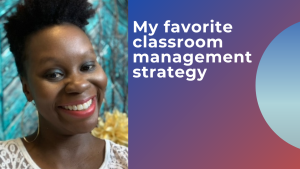I want to tell you some things about when a student is misbehaving; we all have those ones. Those who misbehave the most end up being like my favorite by the end of the school year, sometimes, well, sometimes. I wanted to share with you that when I taught primary, you know, the “take- a- brake” chair, and those of you that follow the Responsive Classroom model, and I do to a degree. Still, I wanted to share with you that if there was a student who needed your extra attention, you know, even if they are negative, they always want your extra attention.
I made a little, not necessarily a “take- a- break” desk, but I used to call the executive desk. And in first grade, when I taught for several years, that executive desk would be right at the side of my desk; this was pre-pandemic, mind you, that little boy or girl that just needed that little extra attention will extra, they would sit up even taller. Because I would say, “Oh, you newly got promoted to the executive desk.” And that kid would go up like, “Oh, yes, I did.” And they would march and sit right next to my desk, not knowing, “Oh, well, I need to do a little bit more redirecting as a teacher and keep my extra tabs on that child.”
I’m gonna name it something where they don’t think they’re actually taking a break because they’re at the executive desk. And executives do essential things. So that’s why they’re at the executive desk. And all the other students would look at him like I wanted to be at that executive desk. I said, “no, no.” I would say to my students sometimes executives need more one-on-one time with the classroom’s boss. And that’s Mrs. Edmunds. And the other students will go, “Oh, okay.” “Make sense.” So what you’re doing at your table is exactly what the boss Mrs. Edmunds needs for you to do right now.
But this child, I would say their name and need more one-on-one time with the boss. So that’s why they are sitting at the executive desk. Now, I call it an executive desk because I don’t want my students to feel shame, even if I need to redirect them or ensure they are on task. For me, to have that close proximity was crucial. Mind you, this was pre-pandemic. You’ll have to be a little more creative with your executive desks. I wanted to ensure that the students still knew I was focused on them. But also, they were in a safe space away from their peers.
Another time, I would also keep that executive child near me. Mind you, this is pre-pandemic, so you have to use your social distance educators. But I used to call them my right-hand boy or my right-hand girl in my class, and these were first graders that I taught all the way to fifth grade. And when I would get ready out to my hallway, if that student wasn’t standing next to me, the whole class wasn’t going, and I would go, “Oh, I need my right-hand boy.” “Oh, I need my right-hand girl.” And they knew that they were. But that also gave me tabs on that student. They’re not bothering the rest of my classroom behind me. And they knew that they had me for an extra safety buffer and that they were right nearby if I needed to redirect that student. I just wanted to give you some tips and tricks on how I have used my classroom management that help my classroom community feel and run smoothly.
